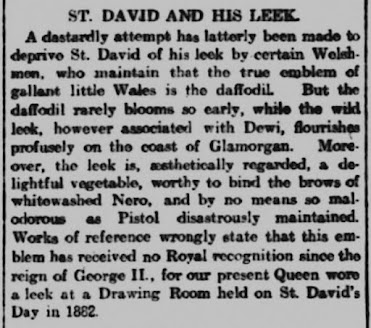Long before the yellow daffodil became the recognisable symbol of Wales, the humble leek reigned supreme. But what are the other sides to its story? Here are five short anecdotes...
 |
| King Cadwaladr holding a leek. |
The noble leek of Wales begins its story in a boggy field in what is now South Yorkshire. The year is 633 AD and Welsh troops led by King Cadwaladr are preparing for battle against the Northumbrian King Edwin's forces. Legend says that Hatfield Chase, the arena in which this great battle would occur, was brimming with leeks. Seeing this abundance, Cadwaladr had a bright idea. He ordered his men to don the leeks in order to differentiate themselves from the advancing enemy. Cadwaladr's leek-clad army were victorious, and the pungent vegetable became a symbol of Cymric pride and good fortune.
 |
| Bust of Emperor Nero. |
THE EMPEROR WHO ONLY ATE LEEKS
The leek's influence was not exclusive to Wales. In Ancient Rome, the vegetable gained celebrity status due to its popularity with the Emperor Nero. He periodically consumed nothing but leeks and oil, as he believed it improved the quality of his voice. Whether or not Nero's wish was granted, his peculiar appetite earned him the nickname porrophagus, or 'leek-eater'!
 |
| Lambert & Butler "Interesting Customs..." series of cigarette cards. New York Public Library digital archive. |
ROYAL SEAL OF APPROVAL
Paying homage to the legend of Cadwaladr's leek-wearing army, members of the Welsh Guards still sport the emblem of a gold leek on their caps! Traditionally, the Guardsmen are presented with their leek cap badges in an annual St David's Day ceremony. For the scaled-down 'Trooping The Colour' in 2020, the Queen donned a diamond leek brooch in support of the Welsh Guards who performed at the ceremony alone.
 |
| L: 1985 leek and coronet. R: 2013 leek and daffodil. |
Leeks continued their royal association by featuring on British coins. In 1985 and 1990, British £1 coins bore the design of a leek in a coronet, and in 2013 the leek and daffodil featured together representing Wales as part of the home countries series. However, the marriage of leek and daffodil wasn't always so harmonious...
 |
| Bradford Daily Telegraph, March 1906. Newspaper image © The British Library Board. All rights reserved. With thanks to The British Newspaper Archive. ([source] [www.britishnewspaperarchive.co.uk]) |
LEEK VS DAFFODIL
Although the daffodil has been associated with Wales since the 20th century, the leek pre-dates it as a national symbol. Perhaps some of the confusion is fuelled by how misleadingly similar the terms are in Welsh. Both cennin (leeks) and cennin Pedr (Peter's leeks, or daffodils) have had their supporters. In one corner of the ring is the impassioned writer of this 1906 article, clearly championing the "delightful vegetable". In the other corner is prominent Welsh journalist and Liberal politician W. Llewelyn Williams, avowing that the "charming flower" of Wales should not be upstaged by a "stinking" leek. [Bournemouth Guardian, October 1912].
 |
| Painting of William Price of Llantrisant dressed as a druid. A C Hemming, 1912. |
GREEN MAGIC
In pre-Roman Britain, the Druids worshipped trees, flowers and plants. The leek was held in high regard by these sages as it was believed to have a host of healing properties. It was believed that leeks could cure common colds, alleviate pain during childbirth, defend against battle wounds and lightning strikes, and keep evil spirits at bay.
The leek has even been attributed with match-making powers. In Welsh folklore, it was believed that a maiden who slept with a leek under her pillow on St David's Day would see an apparition of her sweetheart in her dreams!
However, don't get too swept up in the romance. The Buddhist monks of the Mahayana school would warn against consumption of this pungent foodstuff, believing it can over-excite the senses.
Whether or not leeks excite your senses, we hope you enjoyed this selection of short stories concerning the humble leek. Happy St David's Day! Or if you prefer, Dydd Gŵyl Dewi Hapus!
Until next time,
Comments
Post a Comment